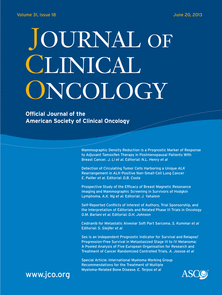
Interval-compressed chemotherapy effective in treatment of localized Ewing sarcoma

Interval-compressed chemotherapy effective in treatment of localized Ewing sarcoma
Randomized controlled trial of interval-compressed chemotherapy for the treatment of localized Ewing sarcoma: a report from the Children's Oncology Group
J Clin Oncol. 2012 Nov 20;30(33):4148-54. doi: 10.1200/JCO.2011.41.5703. Epub 2012 Oct 22Did you know you're eligible to earn 0.5 CME credits for reading this report? Click Here
Synopsis
568 patients with localized Ewing sarcoma were randomized to receive alternating cycles of vincristine - doxorubicin - cyclophosphamide and ifosfamide-etoposide chemotherapy either every 14 or 21 days. Between cycles patients were administered filgrastim and at week 13 all patients received primary tumour treatment. The purpose of this study was to determine whether interval compression was effect...
To view the full content, login to your account,
or start your 30-day FREE Trial today.
FREE TRIAL
LOGIN
Forgot Password?
Explore some of our unlocked ACE Reports below!

Learn about our AI Driven
High Impact Search Feature
Our AI driven High Impact metric calculates the impact an article will have by considering both the publishing journal and the content of the article itself. Built using the latest advances in natural language processing, OE High Impact predicts an article’s future number of citations better than impact factor alone.
Continue



 LOGIN
LOGIN

Join the Conversation
Please Login or Join to leave comments.